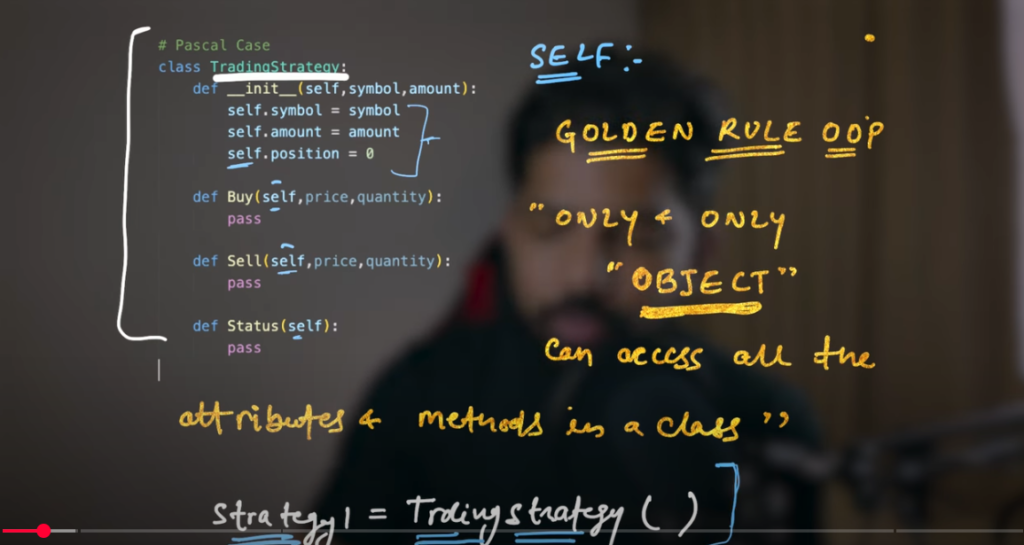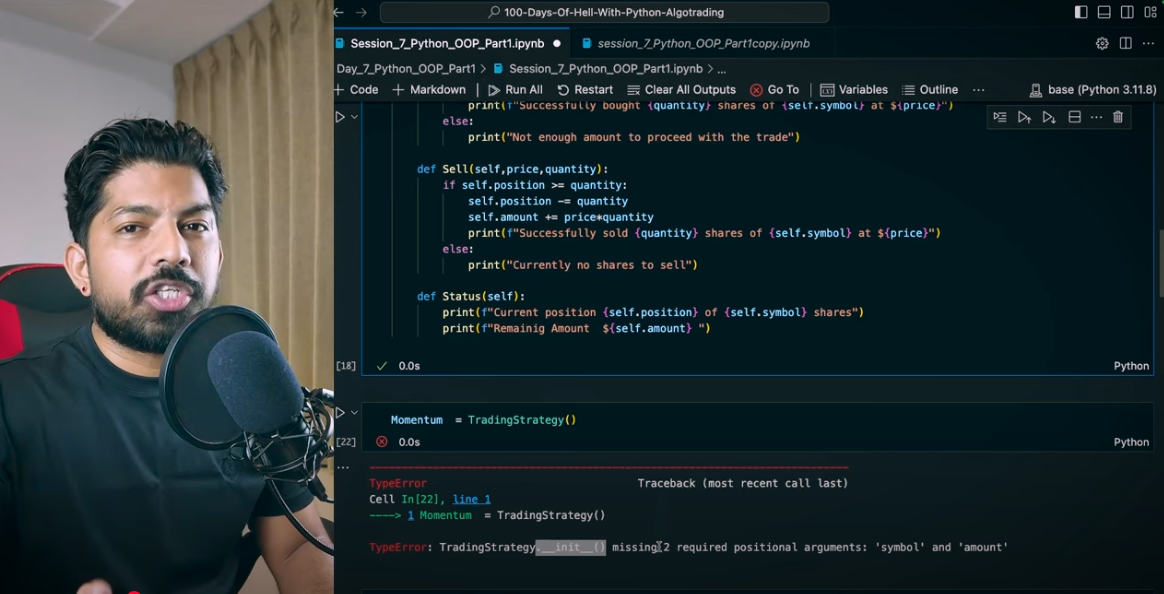Welcome to Day 10 of our 100 Days of Hell with Python Algo Trading! We’ve now completed 10% of this journey, mastering key algorithmic trading Python concepts. In the last session, we explored constructor functions, the self keyword, and OOP’s golden rule. Today, we’ll dive deeper into these concepts before unlocking the power of magic methods (dunder methods) in Python for quantitative traders. Stay tuned as we implement crypto trading strategies and optimize our Freqtrade strategy for real-world markets!
Welcome back to the day 10 of the 100 days of hell with the python Alo trading today I’m very happy that we are able to complete 10% of this 100 days of hell with the python Alo trading so let’s quickly revise what we have done in the previous session and then we’ll proceed with today’s session so so in previous session we have covered that what are Constructor function and what is self keyword and what is the Golden Rule of object oriented programming so today we’ll quickly revise that and then we will see the next topic so as we have covered the golden rule of objectoriented programming that only and only objects can access the attributes and methods of a class right and what are the objects so let’s see this is a class and when I create an object like strategy 1 is equals to the class name right trading strategy and parenthesis so this is the class name and this is the object name correct so when we create an object of this class and this object is known as the instance of that class correct so as soon as we create this object this Constructor function of the class gets executed right and whatever inside this it will be executed so now the question is is it possible that these functions can talk with each other without the help of self you just let me know in the comments can is it possible or not the first question is that and why we are using this self everywhere so let’s say in this Constructor function we have a self then again when we have the variables here also we have prefix as self and again in all these functions we have mentioned the self as parameter so the question is what is the need of this self so if you remove the self from all these functions whether these functions will be able to talk with each other or not and whether these attributes will be able to talk with other methods or not the question is that so in order to understand that we have to run this program and then.





We will see the answer so let’s go to the computer screen and run this program okay so now we have to run this program so what I’ll do I’ll just go so first of all let’s run this cell and I’ll hit enter here and and now again hit enter so you can say that we have the output successfully bought three shares of e at 1200 correct and now when we check the status it is working fine and it will show us the status that current position three of e shares and remaining amount 1400 right that’s working perfectly fine so let’s say what I’ll do I’ll just remove these these two arguments here okay and when I hit shift enter it says missing two required positional arguments symbol and amount it says trading strategy dot The Constructor function in it and then it says missing two required positional arguments symbol and amount okay so now let’s go to this Constructor function and check so here we have this Constructor function but when we check here here we have three parameters right but here in the error it says only two required position arguments so that’s some contradiction correct so in order to understand that what we will do let me remove this self from here okay and now again when I hit shift enter uh while creating object it saves me missing one required positional argument amount why here you can see we have two parameters symbol and amount but here it says me only amount so that’s some contradiction and it becomes so confusing for everyone that how this is happening earlier we had three parameters but it says only two is missing that is symbol and amount now when I remove the self it saves me only one is missing so now with this example.
We can infer two things and for that you have to remember the golden rule of O op right that is only and only objects can access the attributes and methods of the class class and here when we were trying to access this with the help of object we were able to access but when we remove this self from here we are not able to access so means we can say that the self was nothing but the object itself so what was happening here when we create this object automatically this momentum becomes self and it is being passed as an argument from this to this parameter right so when I add here okay and again when I hit shift enter and again so now it says me missing two required position arguments means here the parameters are three means self is already here right so whenever we create an object the momentum is automatically being passed to this parameter self so means the momentum object is already there because as per the golden rule only objects can access the methods and attributes okay that is the first thing again if I remove this self and when I hit shift enter and again to run this cell it says me missing one required positional argument amount that means the symbol is no longer required why because now the symbol is being treated as self means there is no need to mention the specific self instead of that we can put anything here so here if I put symbol here then it becomes this object the momentum and again only amount is missing so if I enter amount here like 2,000 it will say the self is not defined so means I will just replace the self with the symbol and this program will work fine so means with the help of this example.
We have inferred two things the self itself is the object and is disguised as the object and it is being passed as parameter in this Constructor function and the second is it is not mandatory to specifically write the self keyword we can use any word we want correct these two things need to be keep in mind while creating the classes okay now what we can do I’ll just write the self again for the convenience self and here I’ll pass the symbol so let’s say I’ll pass eth here so when I hit shift enter it says me perhaps you forgot a comma yes we forgot actually so I’ll just add here it says text takes two positional arguments but three were given okay we didn’t run this cell and now hopefully yeah it’s working fine so let’s understand it with the help of another example so let’s say what I’ll do here in this Constructor function I’ll just print the ID of self of self and we know that with the help of ID function we can print the memory address of any object in Python so what will happen here when whenever we create any object The Constructor function will gets executed and then it will print the ID of this self parameter here right so let me uh hit shift enter and again and here you can see that we have the memory address of this self keyword 5184 now what I’ll do here let me add another cell here so here what we will do we’ll print the memory address of the momentum object so let’s print ID of momentum so when I hit shift enter we get another address and that is exactly same as the address of the self right and that shows that yeah both self and momentum object are same and we can say that the self is nothing but the object itself because the Golden Rule says only objects can access the methods and attributes of the class so that was thing I wanted to show you and it’s really crucial and many of the people really don’t know this concept they are able to write the codes fluently but the Deep Concepts which are very exclusive they are not able to understand so if you remember this then definitely.
It will help you it will give you an edge while writing the code correct now let’s move to the next topic which is Magic methods that is also known as the dunder methods so let’s see them so first of all let’s define the magic methods so I would say magic method methods are special methods which holds some super power and what is that superar we have already seen in the Constructor function that the init that is also a magic method and that do not need any function call to execute that function right so we can write magic methods do not need function call do not need function call right and we have already seen an example of the magic methods like the in it matter right and one more thing that whenever you see this double underscore you can figure out that this is a magic method correct so in Python we have multiple magic methods like the init and again we have one St Str we will just uh see them quickly and we also have uh R representation then we have addition also then we have addition also uh we have subtraction we have multiplication and we have multiple of these magic methods in Python you can quickly go to the Google and search the list of the magic methods but the main question is what are these magic methods and why we need them right so let me quickly explain you again that so whenever you see the double underscore before the name and after the name these are the magic methods and you can say similarly you can create your own data types with the help of magic methods and we can also say that these magic methods Define the behavior of your custom objects and these makes your class more intuitive and more readable and more comprehensive so in short you can simply say with the help of magic methods we can create our own data types so you can simply say.
We can create our own data types or you can say we can create our own custom objects so custom objects correct and with the help of these magic methods you can make your class more intuitive right so I’ll just write intuitive and also we can use these magic methods to integrate your custom objects with the python seamlessly so we can say integration hopefully you are able to understand the theory behind magic methods and now with the the help of these magic methods we’ll write a program and let’s see how we can utilize these magic methods in our algo trading so let’s move to the screen now what we will do we will create a new class and with the help of these magic methods we’ll be able to perform many operations like subtraction between two trades addition of two trades right so let’s start so first of all what we will do we’ll write the class with the name trades then we’ll Define the constru the function so Define in it and inside that we will give four parameters okay the first itself we know this will be the uh parameter for the object argument then what we will do the first parameter will be the symbol right and then it will be the quantity and next will be the price means the user has to pass the arguments that what symbol he want to trade and at what quantity and at what price right so now what we will do self do symbol is equals to uh symbol then self do quantity self do quantity is equals to uh quantity then we have self do price is equal to the price right now what will happen as soon as we create an object this will gets executed why because this is a magic method with the name in it and this is a Constructor function so it will get automatically executed because magic methods do not need any function call to execute it right so let’s see how these gets executed so what.
We will do here we will just print that yeah I am done already okay to verify that whether this will get executed or not so what we’ll do we’ll go here and we’ll create an object with the name let’s say trade one is equals to trades and so here if I create an object without any uh argument then it will throw an error that name trades is not defined so what we will do first we have to run this and then it will show me missing three required positional arguments symbol quantity and price because this object is by default gets passed as an argument to this parameter whenever we create any object right so now we have to provide these three arguments here so what we will do we’ll provide the values let’s say symbol is equals to BTC then quantity let’s say I want to buy 1.5 is not possible for me right now price is let’s say 71 K approximate right so now when I hit shift enter you can see that yeah I’m done already because this gets executed and all these values are assigned to self do symbol and self do quantity and price the attributes and then it will print the this uh string that yeah I’m done already and one more thing to remember that whenever we pass these parameters here this is known as The parameterized Constructor and when we do not have any parameter here it is known as The unparameterized Constructor it is known as The unparameterized Constructor let’s proceed further so what we will do I’ll just remove this not required right now and I have shift enter and now it is created correct so now what we will do we’ll Define another function and that is also a magic method so Define Dore re PR and you know that whenever you see a double underscore at the end and starting you should know that it is a magic method then I’ll again add the parenthesis and then self so why self because as per the golden rule of the objectoriented programming only and only objects can access the method so here.
Watch this Day 10 video tutorial
Day 10 : Object-Oriented Programming Part – 2
![]()

